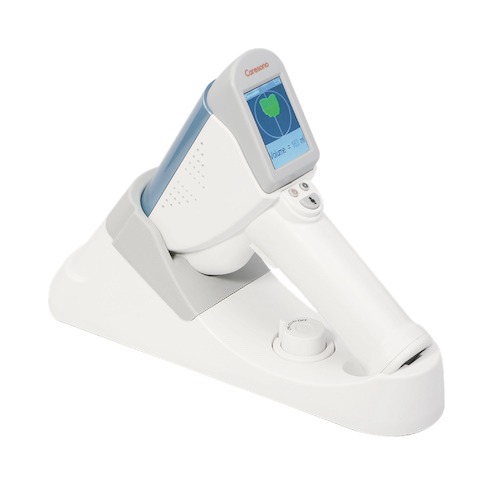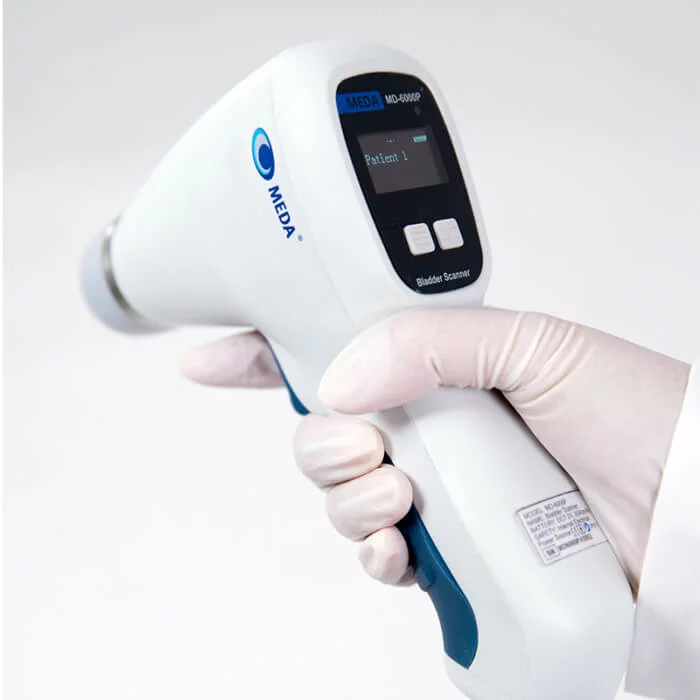For individuals managing chronic bladder conditions or recovering from surgery, regular bladder monitoring can be a vital part of maintaining their health and quality of life. Traditionally, this kind of monitoring required frequent trips to a clinic or hospital, which can be both inconvenient and stressful.
Thanks to advancements in medical technology, bladder scanners are now more accessible than ever for home use. These portable devices allow patients to accurately measure bladder volume from the comfort of their own homes, saving time and reducing the need for clinical visits.
This article is designed to help you find the best bladder scanner for your needs. Whether you’re looking for ease of use, clinical accuracy, or a device that fits your budget, we’ll guide you through the key features to consider. We’ll also introduce two excellent options—the HD2 Hand-Held Bladder Scanner and the MD-6000 PRO Handheld Bladder Scanner—and explain how they can meet a variety of patient needs.
Let’s get started on finding the right bladder scanner to support your health and lifestyle!
Why Consider a Bladder Scanner for Home Use?
Bladder scanners are invaluable tools for individuals dealing with urinary retention or other bladder-related conditions. Traditionally used in clinical settings, these devices are now available in compact, user-friendly models designed for home use. Here’s why investing in a bladder scanner for home use might be a game-changer:
Convenience and Privacy
Frequent visits to a healthcare facility can be time-consuming, costly, and often uncomfortable. Having a bladder scanner at home allows you to monitor your bladder health in the comfort of your own space, ensuring privacy while reducing the stress and inconvenience of regular clinic appointments.
Enhanced Health Monitoring
For individuals with chronic conditions like neurogenic bladder, prostate issues, or post-surgical urinary complications, regular bladder monitoring is essential. A home bladder scanner provides quick, non-invasive insights into your bladder’s volume and functionality, empowering you to track your health and take proactive steps.
Timely Decision-Making
Home-use bladder scanners enable you to detect potential issues, such as urinary retention or incomplete bladder emptying, early. This timely information helps you decide whether medical intervention is needed, preventing complications like urinary tract infections (UTIs) or kidney damage.
Cost-Effectiveness
While purchasing a bladder scanner involves an upfront investment, it can save money in the long run by reducing the need for frequent consultations or hospital visits. This is especially beneficial for individuals requiring consistent monitoring over time.
Empowerment and Independence
Bladder scanners for home use are designed to be user-friendly, even for those without a medical background. Learning to use the device provides a sense of independence, allowing you to take charge of your health with confidence.
Who Can Benefit?
A home bladder scanner is particularly beneficial for:
- Individuals with chronic urinary retention or difficulty emptying the bladder.
- Post-surgical patients recovering from urological or pelvic procedures.
- People with neurogenic bladder conditions caused by spinal cord injuries, multiple sclerosis, or diabetes.
- Caregivers managing the health of elderly or immobile family members.
Investing in a bladder scanner for home use can improve your quality of life, provide peace of mind, and help you stay on top of your health without the hassle of frequent medical visits.

Key Considerations When Choosing a Bladder Scanner
Choosing the right bladder scanner for home use requires careful thought, as the device must meet your specific needs while addressing common concerns. Below are the key factors to consider when selecting a bladder scanner:
Ease of Use
For home users, simplicity is essential. Look for a bladder scanner with an intuitive interface, clear instructions, and minimal setup requirements. Devices designed for non-medical users often come with user-friendly touchscreens, straightforward menus, and step-by-step guides. Ensuring that you feel confident using the scanner will reduce stress and make it a more effective tool for your healthcare needs.
Accuracy and Reliability
A bladder scanner is only as good as its accuracy. The device you choose should provide clinically reliable measurements to help you monitor your bladder health effectively. Inconsistent or inaccurate readings can lead to unnecessary worry or missed medical issues. Look for devices with proven accuracy and trusted reviews, especially from healthcare professionals.
Portability
A portable bladder scanner can make a significant difference for home use. Compact, lightweight devices are easier to handle, store, and transport. Portability is particularly beneficial for older adults or those with limited mobility, ensuring that the scanner can be used comfortably in any setting.
Affordability
While bladder scanners are a valuable investment, cost is often a key concern for home users. It’s important to find a device that strikes the right balance between affordability and functionality. Some models offer advanced features that might not be necessary for every user, so focus on the features you truly need to avoid overspending.
Durability and Maintenance
Since a bladder scanner is a long-term investment, durability is crucial. Choose a device made from high-quality materials that can withstand regular use. Additionally, consider the availability of a manufacturer’s warranty, service support, and access to replacement parts or accessories. Maintenance should be straightforward, with clear cleaning and care instructions provided.
Integration with Health Monitoring
For patients who need to track their bladder health over time, integration with apps or electronic health records can be a game-changer. Some bladder scanners allow you to save and share your results with your healthcare provider, enabling better communication and continuity of care.
Safety
Safety is particularly important for patients with limited dexterity or underlying health conditions. Ensure the scanner is ergonomically designed and easy to operate without causing strain. Devices with clear and visible displays also minimize the risk of misinterpretation.
By keeping these key considerations in mind, you can choose a bladder scanner that not only meets your medical needs but also fits seamlessly into your daily routine. The right device will provide peace of mind, enhance your independence, and improve your ability to monitor your health effectively at home.
Top Picks for Home Bladder Scanners
If you’re considering a bladder scanner for home use, choosing the right model is essential to ensure ease of use, accuracy, and convenience.
Below are our two top recommendations: the HD2 Hand-Held Bladder Scanner and the MD-6000 PRO Handheld Bladder Scanner.
Both devices are portable, reliable, and designed with features that address the needs of home users.

HD2 Hand-Held Bladder Scanner
The HD2 Bladder Scanner is a compact, user-friendly device designed for home use, offering excellent value for money.
Key Features:
- Ease of Use: The HD2 is equipped with a straightforward interface, making it easy for non-medical users to operate.
- High Accuracy: Delivers reliable bladder volume measurements in just a few seconds.
- Portability: Lightweight and compact, it can be stored or carried with ease.
- Affordability: A cost-effective option for patients who need accurate monitoring without overspending.
Who It’s Best For:
The HD2 is ideal for individuals looking for a practical, budget-friendly bladder scanner that doesn’t compromise on performance. Its simplicity and portability make it perfect for elderly users or those with limited technical experience.
Chosen because:
- Eliminates the complexity of use with a simple design.
- Provides an affordable option without sacrificing quality.

MD-6000 PRO Handheld Bladder Scanner
The MD-6000 PRO is a premium bladder scanner with advanced features tailored for more detailed monitoring and integration with modern healthcare tools.
Key Features:
- Advanced Software: Offers enhanced accuracy and detailed bladder imaging for precise measurements.
- Data Integration: Supports connectivity with apps and other health monitoring tools, enabling easy data tracking and sharing with healthcare providers.
- Durability: Built to last, with a robust design and high-quality materials.
- Portability: Lightweight and sleek, perfect for both home and travel use.
Who It’s Best For:
The MD-6000 PRO is best suited for users who need advanced functionality, such as patients with chronic conditions requiring detailed and consistent monitoring or those who want seamless data sharing with their medical team.
Chosen because:
- Provides professional-grade accuracy for peace of mind.
- Offers integration with health monitoring apps for better tracking and communication.
Comparison at a Glance
| Feature | HD2 Hand-Held Bladder Scanner | MD-6000 PRO Handheld Bladder Scanner |
|---|---|---|
| Ease of Use | Simple and beginner-friendly | Slightly advanced interface |
| Accuracy | High accuracy | Professional-grade precision |
| Portability | Lightweight and compact | Sleek and portable |
| Data Integration | Not available | App and data-sharing enabled |
| Price Range | Affordable | Higher investment |
| Best For | General home users, elderly patients | Patients requiring advanced features |
Making the Right Choice
Both the HD2 and MD-6000 PRO are excellent options for home bladder scanning. The HD2 is perfect for those seeking a reliable, easy-to-use device on a budget, while the MD-6000 PRO caters to patients needing advanced features and professional-level accuracy.
Explore these models further to find the one that best suits your needs and lifestyle. If you’re unsure, reach out to our team for personalized recommendations.
How to Choose the Right Bladder Scanner for Your Needs
Selecting the right bladder scanner for home use is a crucial step toward managing your bladder health effectively and comfortably. With a variety of models available, consider the following tips to make the best choice for your specific needs:
1. Understand Your Medical Requirements
Your medical condition will significantly influence the type of bladder scanner you need. Consider the following factors:
- Chronic Bladder Issues: If you have a condition like urinary retention or neurogenic bladder, choose a scanner with high accuracy and reliability.
- Post-Surgical Monitoring: Look for a device that is easy to use and provides quick, consistent results for routine checks.
- General Health Tracking: If you need to monitor your bladder health occasionally, a simpler, more affordable scanner like the HD2 may suffice.
2. Consider Your Comfort with Technology
Evaluate your familiarity with using medical devices and technology:
- If you prefer simplicity, opt for a scanner with a user-friendly interface and straightforward operation, such as the HD2 Hand-Held Bladder Scanner.
- For those comfortable with advanced features, a model like the MD-6000 PRO, which includes app integration and detailed imaging, might be a better fit.
3. Factor in Portability and Storage
If you need a device for home use, portability and ease of storage are essential. A lightweight and compact scanner is easier to handle, especially for older adults or individuals with mobility challenges. Both the HD2 and MD-6000 PRO are designed with portability in mind.
4. Align the Cost with Your Budget
Bladder scanners vary in price depending on their features and capabilities.
- Affordable Options: The HD2 offers excellent value for money, making it a great choice for patients who need a reliable device on a budget.
- Premium Features: The MD-6000 PRO, while more expensive, provides advanced functionality for those requiring detailed monitoring and data integration.
5. Check for Support and Training Resources
Ensure the scanner you choose comes with adequate support and training materials. This may include:
- Easy-to-follow user manuals.
- Online tutorials or customer service support for troubleshooting.
- Warranty and maintenance services for long-term peace of mind.
6. Think About Data Integration Needs
For patients who want to share their results with healthcare providers, choose a scanner that allows data integration, like the MD-6000 PRO. This feature helps maintain continuity of care by enabling seamless communication between you and your medical team.
7. Seek Professional Advice
If you’re unsure which scanner suits your needs best, consult with your healthcare provider or reach out to experts like the team at ultrasound-scanners.co.uk. They can provide personalized recommendations based on your medical history and usage requirements.
Making the Right Decision
Ultimately, the right bladder scanner for you will depend on your unique needs, preferences, and budget. By considering the factors above, you can confidently select a device that will help you manage your bladder health effectively, giving you peace of mind and greater independence in your care.
If you’re ready to make a decision, explore our HD2 Hand-Held Bladder Scanner and MD-6000 PRO Handheld Bladder Scanner for detailed specifications and expert support.
FAQs
Here are some frequently asked questions about bladder scanners for home use to help you make an informed decision:
Are bladder scanners safe for home use?
Yes, bladder scanners are completely safe for home use when used as directed. They use ultrasound technology, which is non-invasive, radiation-free, and painless. Ensure you follow the user manual and any training provided to operate the device correctly.
How accurate are handheld bladder scanners?
Handheld bladder scanners, like the HD2 and MD-6000 PRO, are designed to deliver highly accurate measurements of bladder volume. However, accuracy can depend on proper device usage and following the manufacturer’s instructions. The MD-6000 PRO, for example, offers professional-grade precision for advanced monitoring.
Do bladder scanners require professional training to use?
Most modern bladder scanners, such as the HD2, are designed to be user-friendly and do not require professional training. They come with easy-to-follow guides, and some even offer tutorial videos. For more advanced devices like the MD-6000 PRO, basic familiarity with the features may be helpful but not mandatory.
Can I share my results with my doctor?
Yes, some bladder scanners, such as the MD-6000 PRO, allow you to integrate your readings with apps or export data that can be shared with your healthcare provider. This feature can be especially useful for regular monitoring and consultations.
How much do bladder scanners cost?
The cost of bladder scanners varies depending on the model and its features. Affordable options like the HD2 are budget-friendly, while advanced models like the MD-6000 PRO may have a higher price due to additional features such as enhanced accuracy and data integration.
Are bladder scanners portable?
Yes, most handheld bladder scanners are designed to be portable. Both the HD2 and MD-6000 PRO are lightweight and compact, making them easy to store, handle, and transport.
How do I maintain my bladder scanner?
Maintenance is simple and involves keeping the device clean and following the manufacturer’s guidelines. Most scanners include instructions on how to disinfect the probe and handle the device safely. Regular calibration checks may also be recommended for optimal performance.
Who should use a bladder scanner at home?
Home bladder scanners are ideal for individuals with specific medical needs, such as:
- Monitoring urinary retention or chronic bladder conditions.
- Post-surgery recovery.
- Managing neurogenic bladder conditions.
Consult with your doctor to determine if a bladder scanner is suitable for your condition.
Do bladder scanners come with a warranty?
Yes, most bladder scanners, including the HD2 and MD-6000 PRO, come with a warranty. Check the product details for specific warranty terms and coverage, including repair or replacement options.
